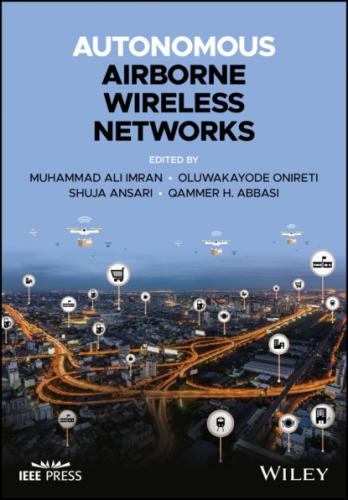2.4.1 Background
In wireless communications, several propagation phenomena occur when electromagnetic waves radiate from the transmitter in several directions and interact with the surrounding environment before reaching the receiver. As shown in Figure 2.3, propagation phenomena such as reflection, scattering, diffraction, and penetration occur due to the natural obstacles and buildings, which provoke the multiple realization of the signal transmitted from the UAV, often known as multipath components (MPC). Thus, each component received at the receiver with different amplitude, phase, and delay, and the resultant signal is a superposition of multiple copies of the transmitted signal, which can interfere either constructively or destructively depending on their respective random phases [6]. Typically, several fading mechanisms are added linearly in dB to represent the radio channel as
Figure 2.3 Multipath air‐to‐ground propagation in urban setting.
where
Terrestrial channel: For suburban and urban environments, altitude is between 10 and 22.5 m, respectively [7]. In this case, the terrestrial channel models can be used to model AG propagation because the airborne UAV is below the rooftop level. As a result, NLoS is the dominant component in the propagation.
Obstructed AG channel: For suburban and urban environments, altitude is 10–40 m and 22.5–100 m, respectively. In this case, LoS probability is higher than that of the terrestrial channels.
High‐altitude AG channel: All channels are in LoS for the altitude ranges between 100 and 300 m or above. Consequently, the propagation is similar to that in the free space case. Moreover, no shadowing is experienced for these channels.
2.4.1.1 Path Loss and Large‐Scale Fading
Air‐to‐Air Channel Free space path loss model is the simplest channel model to represent the AA propagation at a relatively high altitude. Thus, the received power is given by [6]
where
(2.3)
Air‐to‐Ground Channel In urban environment, the AG channel may not experience complete free space propagation. In the existing literature on UAV communications, the log‐distance model is the prominently used path loss model due to its simplicity and applicability when environmental parameters are difficult to define. Therefore, path loss in dB is given by
(2.4)
where
Another popular channel model to characterize the AG propagation in UAV communications is the probabilistic path loss model in [4] and [17]. In [17], the path loss between the ground device and the UAV is dependent on the position of the UAV and the propagation environments (e.g. suburban, urban, dense‐urban, high‐rise). Consequently, during the AG radio propagation, the communication link can be either LoS or NLoS depending on the environment. Many of the existing works [18–35] on UAV communications adopted the probabilistic path loss model of [4] and [17]. In these works, the probability of occurrence of LoS and NLoS links are functions of the environmental parameters, height of the buildings, and the elevation angle between the ground device and the UAV. This model is based on environmental parameters defined
